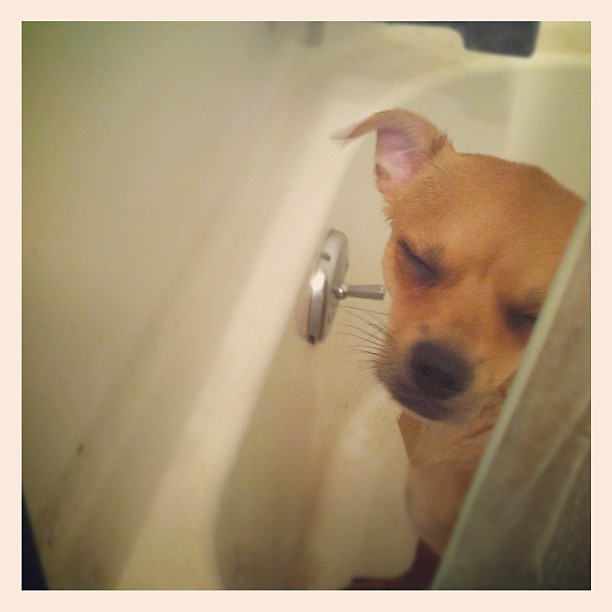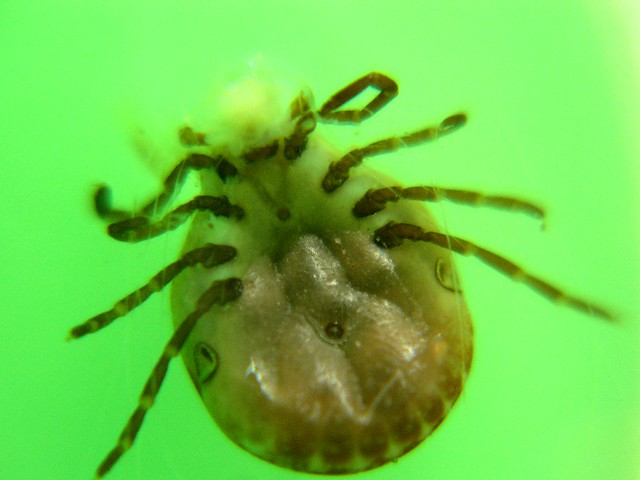
A Labrador Retriever standing with hind legs closes together to compensate
for weak hips caused by an altered gait from hip dysplasia.
(Photo credit: Wikipedia)
Is your dog a little less enthusiastic about his daily walks? Is he reluctant to get up or lie down? Do his joints click as he walks? If so, there’s a chance your buddy is suffering from canine arthritis.
Just as with humans, arthritis in dogs can be one of a variety of types, but the most common is osteoarthritis.
What is Osteoarthritis and what causes it?
Cartilage in joints acts as a buffer between bones. Sometimes, that cartilage degrades and deteriorates, reducing the buffer between bones, sometimes to the point where there is direct bone-to-bone contact, which is extremely painful for the dog.
There is no single cause of arthritis. Genetics and breeding have made certain breeds more susceptible to hip dysplasia, which often leads to arthritis. Obesity in dogs can also contribute to arthritic conditions. Sometimes young dogs can suffer from arthritis if their bones don’t develop correctly. An injury to a limb can also result in arthritis later in life.
Symptoms
If your dog displays some of the following symptoms, you should consult a veterinarian regarding the possibility of canine arthritis:
· Inactivity
· Favoring of one limb
· Reluctance to get up or lie down
· Clicking of joints
· Visible pain when walking
· Swelling of Joints
· Whimpering/Crying
· Reluctance to climb stairs
· Stiffness after getting up
Treatment
There is no cure for canine arthritis. Generally, treatment is dedicated to reducing the inflammation, and managing the pain. You and your veterinarian should decide whether prescribed drugs are warranted.
Glucosamine and Chondroitin have shown good results in reducing the inflammation, and therefore the pain, in the joints in many dogs. Commercial supplements providing this combination include Cosequin and Arthogen, among others. They are available without a prescription.
Changing the animal’s diet might also help. For overweight dogs, a “light” product may be in order. Some pet owners may prefer to go the all-natural route, while others might consider dog food that contains Glucosamine and Chondroitin.
Alternative treatments, such as acupuncture and chiropractic have also had positive results for some arthritic canines.
What Can I Do to Make my Arthritic Dog More Comfortable?
If your dog shows signs of arthritis in his neck or shoulders, raise his food and water bowl by using a stand or “dog diner”.
When the weather is cold or damp, keep your buddy cozy and warm.
Apply moist heat to arthritic joints, in the form of a hot towel, or a towel-wrapped hot water bottle. Never use a heating pad, as it could lead to accidental burning.
Utilize ramps instead of stairs when possible.
Maintain a reasonable activity level. Exercise and mild activity will help stop joints from deteriorating further.
Conclusion
The sad fact is, that once a dog develops arthritis, he will suffer with it for the rest of his life, and all that can be done for him is to make him as comfortable as possible by maintaining a reasonable activity level, feeding the proper diet, and/or treating with over-the-counter medications, prescribed drugs, or holistic remedies. And a lot of love.








